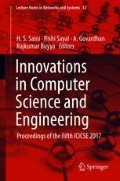Abstract
Other than speech and body language, facial expression is one of the most prominent ways by which humans communicate their feelings to other humans. The task of detection of emotions in real time accurately has been a very arduous task as methods giving good results are generally computationally exhaustive, whereas the methods that has low computation time do not yield good results. In our system, we have maintained the highest accuracy possible while keeping the computational cost minimal. Various descriptors were tried to test the best trade-off between accuracy and time. We used Distance Metric Learning (DML) for significantly improving the results when the features were mapped to higher dimension. The dataset used is the extended Cohn–Kanade dataset. The system was also tested on subjects that were not available in the dataset and gives a comparable result with other real-time emotion detection system.
Access this chapter
Tax calculation will be finalised at checkout
Purchases are for personal use only
References
L. C. De Silva, T. Miyasato, and R. Natatsu. Facial emotion recognition using multimodal information. In Proc. IEEE Int. Conf. on Information, Communications and Signal Processing (ICICS’97), pages 397–401, Singapore, Sept. 1997.
L. S. Chen. Joint processing of audio-visual information for the recognition of emotional expressions in human-computer interaction. PhD thesis, University of Illinois at Urbana-Champaign, Dept. of Electrical Engineering, 2000.
L. S. Chen, H. Tao, T. S. Huang, T. Miyasato, and R. Nakatsu. Emotion recognition from audiovisual information. In Proc. IEEE Workshop on Multimedia Signal Processing, pages 83–88, Los Angeles, CA, USA, Dec. 7–9, 1998. s.
Rathee, N., Vaish, A., & Gupta, S. (2016, April). Adaptive system to learn and recognize emotional state of mind. In Computing, Communication and Automation (ICCCA), 2016 International Conference on (pp. 32–36). IEEE.
Kaltwang, S., Rudovic, O., & Pantic, M. (2012). Continuous pain intensity estimation from facial expressions. Advances in visual computing, 368–377.
Cohn, J. F., Kruez, T. S., Matthews, I., Yang, Y., Nguyen, M. H., Padilla, M. T., & De la Torre, F. (2009, September). Detecting depression from facial actions and vocal prosody. In Affective Computing and Intelligent Interaction and Workshops, 2009. ACII 2009. 3rd International Conference on (pp. 1–7). IEEE.
Ekman, P., & Friesen, W. V. (1971). Constants across cultures in the face and emotion. Journal of personality and social psychology, 17(2), 124.
Lucey, P., Cohn, J. F., Kanade, T., Saragih, J., Ambadar, Z., & Matthews, I. (2010, June). The Extended Cohn-Kanade Dataset (CK+): A complete dataset for action unit and emotion-specified expression. In Computer Vision and Pattern Recognition Workshops (CVPRW), 2010 IEEE Computer Society Conference on (pp. 94–101). IEEE.
Rathee, N., & Ganotra, D. (2017). A Novel Approach for Continuous Pain Intensity Estimation. In Proceeding of International Conference on Intelligent Communication, Control and Devices (pp. 443–450). Springer Singapore.
J. T. Cacioppo and L. G. Tassinary. Inferring psychological significance from physiological signals. American Psychologist, 45: 16–28, January 1990.
Y. Yacoob and L. Davis, “Recognizing human facial expressions from long image sequences using optical flow,” IEEE Transactions on Pattern Analysis and Machine Intelligence, vol. 18, pp. 636–642, June 1996.
Bellet, A., Habrard, A., & Sebban, M. (2013). A survey on metric learning for feature vectors and structured data. arXiv preprint arXiv:1306.6709.
Declaration
Author(s) hereby declare that they have obtained required permissions from the research participants to use their recorded video, audio, and images for testing of the algorithm and for the publication of the research work.
Author information
Authors and Affiliations
Corresponding authors
Editor information
Editors and Affiliations
Rights and permissions
Copyright information
© 2019 Springer Nature Singapore Pte Ltd.
About this paper
Cite this paper
Vaish, A., Gupta, S., Rathee, N. (2019). Enhancing Emotion Detection Using Metric Learning Approach. In: Saini, H., Sayal, R., Govardhan, A., Buyya, R. (eds) Innovations in Computer Science and Engineering. Lecture Notes in Networks and Systems, vol 32. Springer, Singapore. https://doi.org/10.1007/978-981-10-8201-6_36
Download citation
DOI: https://doi.org/10.1007/978-981-10-8201-6_36
Published:
Publisher Name: Springer, Singapore
Print ISBN: 978-981-10-8200-9
Online ISBN: 978-981-10-8201-6
eBook Packages: EngineeringEngineering (R0)

